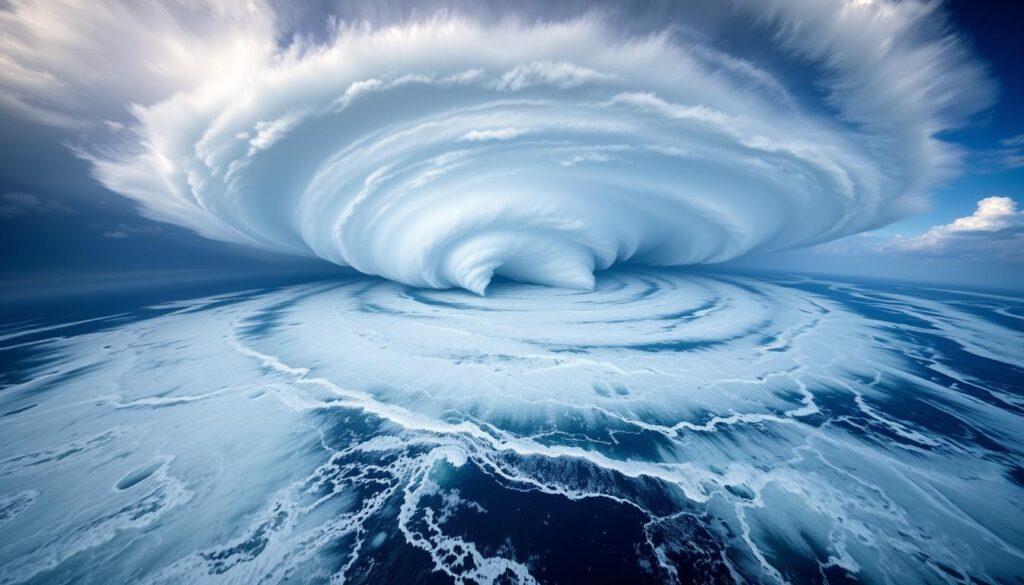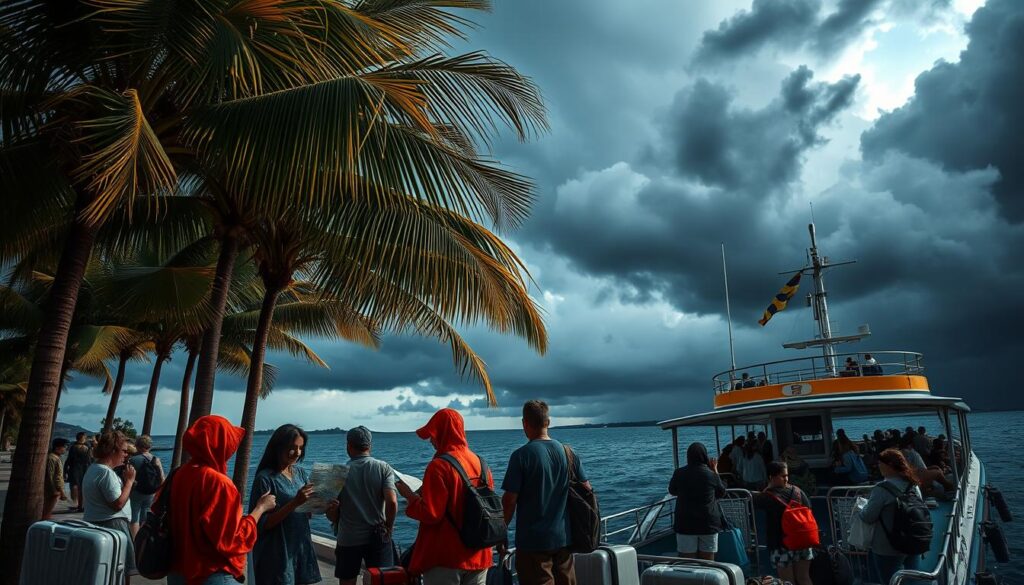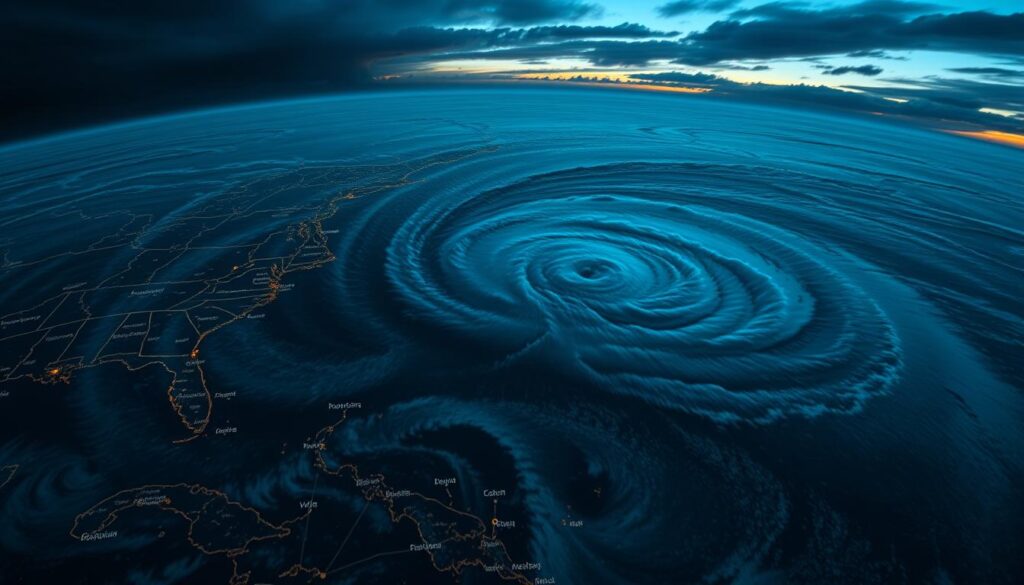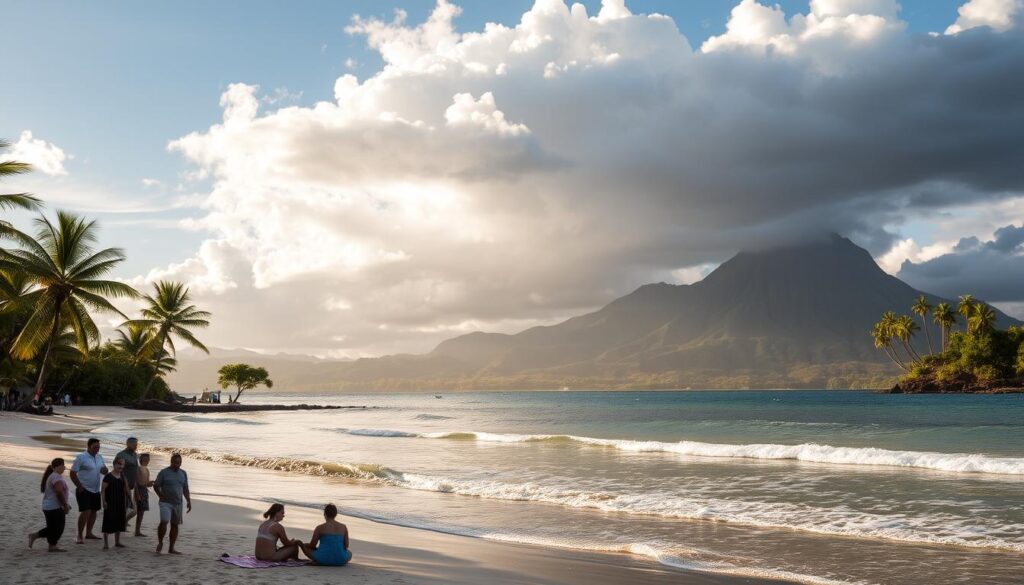Did you know the South Pacific cyclone season lasts about six months? It goes from November to April. This affects many people’s travel plans. If you dream of beautiful beaches and lively cultures, knowing when to visit is key.
Understanding the cyclone season is important for a safe and fun trip. By knowing the cyclone patterns, you can plan your trip better. This way, you can avoid any bad weather.
Key Takeaways
- The cyclone season in the South Pacific runs from November to April.
- Planning your trip around this season is essential for safety and enjoyment.
- Understanding regional weather patterns can enhance your travel experience.
- Optimal travel months offer better opportunities for outdoor activities.
- Different areas may experience cyclones at varying intensities.
Understanding the South Pacific Cyclone Season
The South Pacific has a tropical cyclone season that can mess up travel plans. It usually runs from November to April. During this time, the chance of severe weather, like tropical cyclones, is highest.
Knowing when cyclone season is in the South Pacific is key for planning trips or outdoor activities. This knowledge helps you avoid bad weather and make your travel better.
When you’re getting ready for a trip, knowing about the cyclone season is important. Cyclones bring heavy rain, strong winds, and high humidity. This makes some times worse for exploring.
Learning about the tropical cyclone season can make your trip better. It helps you plan and enjoy your time more.

The Importance of Knowing Timing for Your Trip
Knowing when to travel to the South Pacific is key for a safe and fun trip. You should think about cyclone season travel precautions. Weather can be unpredictable during this time, which might affect your plans.
By knowing the peak and off-peak seasons, you can avoid problems. This helps you plan better and enjoy your trip without worries.
Keeping south pacific travel safety in mind is vital. Knowing when cyclones happen helps you pick safer travel dates. This way, you can enjoy the islands’ beauty and culture without fear.
Using travel safety tips can make your plans even better. Keep an eye on local weather and travel advisories. Being flexible with your plans helps you adapt to any changes. Knowing the right time for your trip makes your adventure in the South Pacific even more rewarding.

South Pacific Cyclone Season: When to Go & When to Avoid
Traveling to the South Pacific is a dream come true, with its beautiful landscapes and calm beaches. But, it’s important to know when to go. The cyclone risk in the south pacific is higher from January to March. Knowing this can make your trip better and safer.
Overview of Cyclone Periods
The cyclone season is from November to April, peaking in early months. Knowing this helps you prepare. Here’s a table showing cyclone frequency and impact:
| Month | Cyclone Frequency | Travel Recommendations |
|---|---|---|
| November | Low to Moderate | Can consider visiting |
| December | Moderate | Stay updated on forecasts |
| January | High | Avoid if possible |
| February | High | Avoid if possible |
| March | Moderate | Alertness recommended |
| April | Low | Good travel month |
Impact on Travel Plans
Traveling during cyclone season can cause problems, like flight cancellations. It’s smart to have backup plans. Knowing cyclone-free travel dates helps you plan without worry. Always check the forecast to adjust your plans and enjoy a worry-free trip.

Best Time to Visit the South Pacific
The best time to visit the South Pacific is from May to October. This time has less rain, nice temperatures, and low humidity. It’s perfect for outdoor fun.
You’ll see the area’s beauty without storms getting in the way.
Dry Season Advantages
Traveling in the dry season has many perks. You’ll enjoy sunny days for beach time or water sports. The scenery is stunning, great for hiking and exploring.
It’s also less crowded, thanks to the south pacific weather guide.
High Season Tourist Appeal
The high season is during summer in the northern hemisphere. It’s busy with tourists and lots of fun activities. You can join in local festivals and events.
It’s lively, but the experiences are worth it. For a quieter trip, try October, November, February, or April. These months have good weather and fewer people. Knowing when to avoid cyclones makes your trip safer and more fun.

Exploring the Wet Season
The wet season in the South Pacific runs from November to April. It brings unique weather that changes how you travel. You’ll see more humidity and showers, but also lush landscapes.
Planning outdoor activities during this time needs careful thought. Knowing the weather helps you enjoy your trip more and avoid problems.
Characteristics of the Wet Season
The wet season has several key traits. Expect warmer temperatures and more humidity, making the air lively. Rain can range from light drizzles to heavy storms, sometimes ruining sunny days.
Traveling during this time means fewer crowds. This lets you see the area’s beauty up close. But, you must plan well because the weather can change suddenly.
Risks of Tropical Storms
Be careful of tropical storms during the wet season. These storms can ruin your plans and be dangerous. It’s important to know how to stay safe.
Keep an eye on weather updates and follow safety advice. Knowing what to do in case of a storm is key. This way, you can enjoy your trip without worries.

Major Cyclone-Prone Regions in the South Pacific
Some areas in the South Pacific are more likely to get hit by cyclones. Places like Fiji, Tonga, and Vanuatu often see many tropical storms. This makes them cyclone-prone regions. Knowing this helps you choose the right place and time to travel.
These countries have plans for south pacific cyclone preparedness. Learning about local safety steps can make your trip better. It lets you enjoy the area’s beauty while staying safe. Make sure you know about cyclone patterns and emergency plans.
| Region | Frequency of Cyclones | Preparedness Measures |
|---|---|---|
| Fiji | High | Local emergency alerts and community shelters |
| Tonga | Moderate | Disaster response training and evacuation plans |
| Vanuatu | High | Warning systems and regular drills |
Knowing about south pacific natural disasters helps you plan better. Keep an eye on weather forecasts and travel alerts. This way, you can stay safe while exploring these beautiful places.
Optimal Travel Months for Activities
Planning your trip to the South Pacific? Knowing the best times for activities can make your trip unforgettable. From whale watching to snorkeling and diving, the right time ensures the best experience.
Whale Watching and Marine Life
July to October is the best time for whale watching. You can see humpback whales in Tonga’s waters. It’s a chance to see these giants up close, a highlight of any South Pacific trip.
Best Snorkeling and Diving Conditions
The dry season, from May to October, is perfect for snorkeling and diving. The water is clear, showing off colorful reefs and marine life. Visiting during these months guarantees an amazing underwater adventure.
| Activity | Optimal Months | Highlights |
|---|---|---|
| Whale Watching | July – October | Humpback whale migration in Tonga |
| Snorkeling/Diving | May – October | Excellent visibility and diverse marine life |
Travel Tips for Avoiding Cyclones
Traveling during cyclone season needs careful planning. Knowing safety tips and the best travel dates can make your trip better. Follow these tips to have a smooth vacation.
Safety Protocols
Keep yourself safe by learning about local emergency contacts and evacuation routes. Here are key cyclone season safety tips:
- Stay updated on weather forecasts.
- Know the location of nearest shelters.
- Have a plan for how to communicate with family and friends.
- Purchase travel insurance that covers cyclone-related disruptions.
Choosing Cyclone-Free Travel Dates
Choosing the right dates is important for a great trip. Here are some south pacific travel recommendations:
- Research the cyclonic activity patterns for your chosen destination.
- Opt for travel during the dry season for better weather conditions.
- Monitor local weather advisories leading up to your trip.
- Plan activities that can be easily rescheduled if necessary.
South Pacific Weather Patterns Explained
The South Pacific has unique weather patterns due to El Niño and La Niña. These events change the temperature and rain, affecting the weather all year. Knowing how these systems work helps plan your trip better.
This area has a warm, humid climate with wet and dry seasons. The wet season brings rain and storms, while the dry season is sunny and dry. Each season offers different travel experiences based on the weather.
Knowing the seasons can improve your trip. The dry season is great for outdoor fun like snorkeling and hiking. The wet season is green and less crowded, but storms are more likely. Understanding the weather helps plan your trip better.
Understanding Regional Climate Variances
The South Pacific is a mix of different climates, changing from island to island. Geographical features and ocean currents play big roles in these changes. For example, Fiji and Samoa have some similar weather, but mountains and the ocean create unique spots.
Travelers need to know about the climate of each island to plan better. Some islands are perfect for sunny beach days and snorkeling in calm seas. Others are great for seeing green landscapes, but you might face more weather risks.
Learning about these differences helps you choose the best places to visit. This way, you can enjoy your trip more and stay safe from bad weather.
| Island | Typical Climate | Best Travel Season | Weather Hazards |
|---|---|---|---|
| Fiji | Tropical, warm with slight seasonal changes | May to October | Heavy rain, cyclones |
| Samoa | Tropical rainforest climate | May to October | Flooding, tropical storms |
| Tonga | Tropical ocean climate | May to November | Strong winds, cyclones |
| Cook Islands | Humid tropical climate | May to October | Storms, flooding |
Conclusion
Knowing about the South Pacific cyclone season is key for a great vacation. This guide has given you the lowdown on the best times to visit and what to do. It also shares tips on staying safe while you’re there.
Staying safe is your top concern when traveling. Whether you want to relax on beautiful beaches or dive into exciting marine activities, knowing the weather is important. Planning your trip right lets you enjoy the South Pacific’s wonders without worrying about cyclones.
With the right preparation, you can travel with confidence. By avoiding cyclones, you’re set for an amazing adventure. Get ready for an unforgettable trip, knowing you’ve taken all the necessary steps for a safe and fun journey.
